-
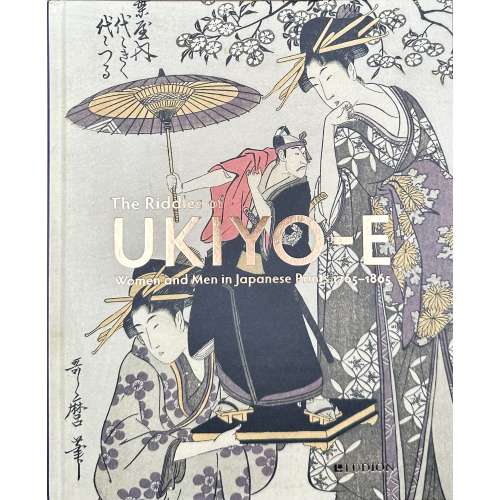 Hardcover volume 295 x 240 mm, pictorial front cover and purple spine with gilt embossed lettering, back cover with orange lettering, craft endpapers, pp.: [1-6] 7-255 [1], profusely illustrated. Exhibition catalogue with 123 reproductions of Japanese woodblock prints. Title-page: The Riddles of | UKIYO-E | Women and Men in Japanese Prints 1765–1865 | Chris Uhlenbeck / Jim Dwinger / Josephine Smit | {publisher’s device LUDION} || Table of contents: Preface; Introduction; Beauties; Shunga; Legends; Kabuki; INDEX; LIST OF WORKS; BIBLIOGRAPHY; AUTHORS.
Hardcover volume 295 x 240 mm, pictorial front cover and purple spine with gilt embossed lettering, back cover with orange lettering, craft endpapers, pp.: [1-6] 7-255 [1], profusely illustrated. Exhibition catalogue with 123 reproductions of Japanese woodblock prints. Title-page: The Riddles of | UKIYO-E | Women and Men in Japanese Prints 1765–1865 | Chris Uhlenbeck / Jim Dwinger / Josephine Smit | {publisher’s device LUDION} || Table of contents: Preface; Introduction; Beauties; Shunga; Legends; Kabuki; INDEX; LIST OF WORKS; BIBLIOGRAPHY; AUTHORS. -
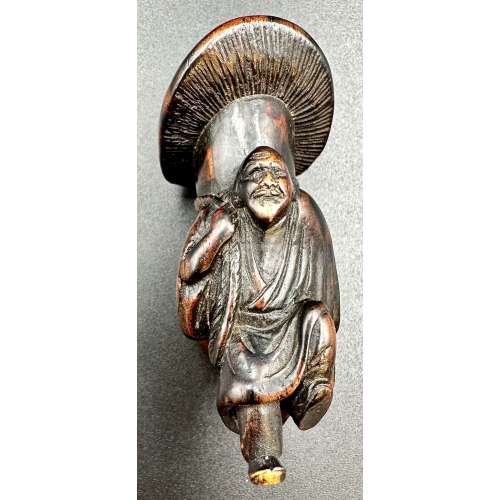
Netsuke with a design of an old man carrying a giant mushroom on his back. Possibly signed on his left foot. According to Merrily Baird (Symbols of Japan, page. 93): ... This prominent use in the symbol-rich netsuke art form, however, reflects more their sexual symbolism than either their dietary appeal or interesting shapes. Mushrooms in Japan are generally a symbol of fertility, with some flat varieties, like shiitake, being associated with females. In contrast, the matsutake mushroom (Armillaria edodes) is a phallic symbol, as befits its thick, spearlike stem and the fact that it is consumed before cap opens.
Seller's description: "The old man carved walking, with one foot slightly raised, wearing a loose fitted robe and carrying a large long-stemmed mushroom on his back. The wood stained and bearing a fine patina. Himotoshi through the mushroom stem". See VO-0270.2018 for the same subject. Late 18th century. Dimensions: 62 mm tall -
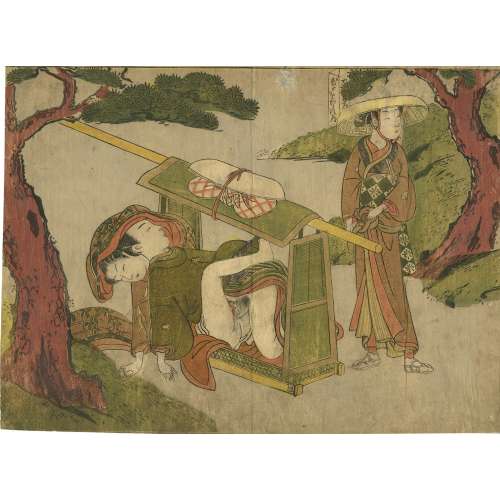 A shunga (erotic) print by Suzuki Harunobu [鈴木 春信] (Japanese, c. 1725 – 1770) depicting a woman making love with a man in the palanquin (のりもの/乗り物) while the other woman "ties a sash about her hips below her obi." The sheet is not signed; however, it is attributed to Harunobu. A reference image can be found in the Metropolitan Museum (NY) collection, Accession Number JP1635:According to the MET "the palanquin ... has carried these courtesans to the shore for a spring outing". Some time ago, a similar print was sold by Richard Kruml (description: A chuban shunga print showing the occupant of a kago in flagrante with one of the porters, having seized the opportunity of a stop on the journey. Published late 1760s. Rare). Another copy was sold at Sotheby's in Paris for €3,360 on November 27, 2002 (Lot 24), with a reproduction of the print's detail and description on p. 39: Suzuki Harunobu (1725 – 1770) | Shunga: couple dans un palanquin, vers 1768-1770, non-signe, cachet non identifé, cachets Charles Mitchell, Huguette Berès, Format chuban, 20.1 x 28.6 cm | 3000 – 4000 € | Il s’agit probablement de trois voyageurs, l’un d’entre eux debout près du palanquin faisant mine d’ignorer la scène. Bibliographie: Delay p. 87. Reference: [LIB-3121.2022] Sotheby's: Collection Huguette Berès – Estampes, dessins et livres illustrés japonais / 2 volumes; vol. 1. — Paris: Sotheby's, 2002.
A shunga (erotic) print by Suzuki Harunobu [鈴木 春信] (Japanese, c. 1725 – 1770) depicting a woman making love with a man in the palanquin (のりもの/乗り物) while the other woman "ties a sash about her hips below her obi." The sheet is not signed; however, it is attributed to Harunobu. A reference image can be found in the Metropolitan Museum (NY) collection, Accession Number JP1635:According to the MET "the palanquin ... has carried these courtesans to the shore for a spring outing". Some time ago, a similar print was sold by Richard Kruml (description: A chuban shunga print showing the occupant of a kago in flagrante with one of the porters, having seized the opportunity of a stop on the journey. Published late 1760s. Rare). Another copy was sold at Sotheby's in Paris for €3,360 on November 27, 2002 (Lot 24), with a reproduction of the print's detail and description on p. 39: Suzuki Harunobu (1725 – 1770) | Shunga: couple dans un palanquin, vers 1768-1770, non-signe, cachet non identifé, cachets Charles Mitchell, Huguette Berès, Format chuban, 20.1 x 28.6 cm | 3000 – 4000 € | Il s’agit probablement de trois voyageurs, l’un d’entre eux debout près du palanquin faisant mine d’ignorer la scène. Bibliographie: Delay p. 87. Reference: [LIB-3121.2022] Sotheby's: Collection Huguette Berès – Estampes, dessins et livres illustrés japonais / 2 volumes; vol. 1. — Paris: Sotheby's, 2002.
http://www.metmuseum.org/art/collection/search/45071
-
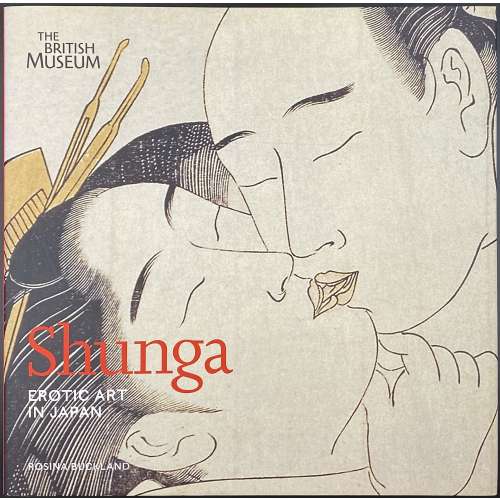 A hardcover pictorial album, 25 x 25.5 cm, bound in black buckram with silver lettering to spine, in pictorial dust jacket; pp.: [1-6] 7-175 [176 blank], total 88 leaves, illustrated in colour throughout. Title-page: Shunga | EROTIC ART | IN JAPAN | ROSINA BUCKLAND | THE BRITISH MUSEUM PRESS || Subject: Art, Japanese – Edo period, 1600-1868; Erotic art – Japan; Prints, Japanese – History. Contributor: Rosina Buckland (British, b. 1974)
A hardcover pictorial album, 25 x 25.5 cm, bound in black buckram with silver lettering to spine, in pictorial dust jacket; pp.: [1-6] 7-175 [176 blank], total 88 leaves, illustrated in colour throughout. Title-page: Shunga | EROTIC ART | IN JAPAN | ROSINA BUCKLAND | THE BRITISH MUSEUM PRESS || Subject: Art, Japanese – Edo period, 1600-1868; Erotic art – Japan; Prints, Japanese – History. Contributor: Rosina Buckland (British, b. 1974) -
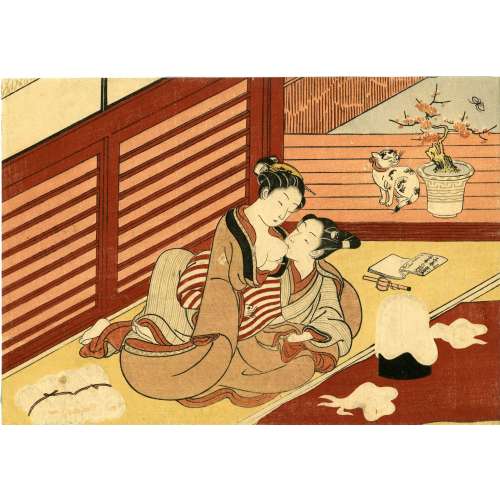 Artist (attributed, no signature): Suzuki Harunobu [鈴木 春信] (Japanese, c. 1725 – 1770). The title is taken from [LIB-1478.2013] Gian Carlo Calza, Stefania Piotti. Poem of the pillow and other stories. — Phaidon Press, 2010; pp. 148-9. Alternative title: Man sucking woman's breast and a cat sitting under a bonsai tree. The open book beside the couple reads 子春 (Koharu). Woodblock print from the series Mirror Picture of Japan (Wakoku kagami); Size: Horizontal chuban; 21 x 26 cm.
Artist (attributed, no signature): Suzuki Harunobu [鈴木 春信] (Japanese, c. 1725 – 1770). The title is taken from [LIB-1478.2013] Gian Carlo Calza, Stefania Piotti. Poem of the pillow and other stories. — Phaidon Press, 2010; pp. 148-9. Alternative title: Man sucking woman's breast and a cat sitting under a bonsai tree. The open book beside the couple reads 子春 (Koharu). Woodblock print from the series Mirror Picture of Japan (Wakoku kagami); Size: Horizontal chuban; 21 x 26 cm. -
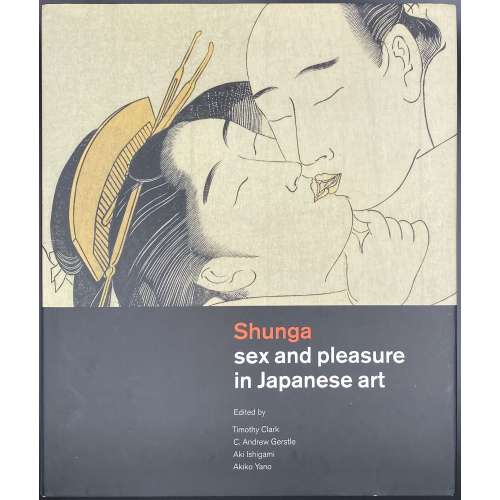 Hardcover volume, 29.6 x 25 x 4 cm, in red cloth with black lettering to spine, in pictorial dust jacket, profusely illustrated in colour; pp.: [1-6] 7-536, total 268 leaves and 2 folding plates extraneous to collation. Title-page: {Hotei's device} Hotei Publishing | Shunga | sex and pleasure in Japanese art | Edited by | Timothy Clark | C. Andrew Gerstle | Aki Ishigami | Akiki Yano || Contents: The Cultural Historical Significance and Importance of Japanese Shunga / Kobayashi Tadashi. Introduction: What Was Shunga? / C. Andrew Gerstle; Who Were the Audiences for Shunga? / Hayakawa Monta. (1) Early Shunga before 1765: Shunga Paintings before the `Floating World' / Akiko Yano; Chinese Chunhua and Japanese Shunga / Ishigami Aki; Shunga and the Rise of Print Culture / Asano Shugo. (2) Masterpieces of Shunga 1765-1850: The Essence of Ukiyo-e Shunga / Kobayashi Tadashi; Erotic Books as Luxury Goods / Ellis Tinios; Listening to the Voices in Shunga / Hayakawa Monta; The Tale of Genji in Shunga / Sato Satoru. (3) Censorship: Timeline of Censorship; Shunga and Censorship in the Edo Period (1600-1868) / Jennifer Preston; Graph of approximate output of shunga print series and books; The Censorship of Shunga in the Modern Era / Ishigami Aki; Shunga Studies in the Showa Era (1926-89) / Shirakura Yoshihiko. (4) Contexts for Shunga: Traditional Uses of Shunga / Yamamoto Yukari; The Distribution and Circulation of Erotic Prints and Books in the Edo Period Laura Moretti; Shunga and Parody / C. Andrew Gerstle; Popular Cults of Sex Organs in Japan / Suzuki Kenko; Grotesque Shunga / Ishigami Aki; Violence in Shunga / Higuchi Kazutaka; Foreign Connections in Shunga / Timon Screech; Children in Shunga / Akiko Yano; Shunga and the Floating World / Matsuba Ryoko. (5) Shunga in the Meiji Era: Erotic Art of the Meiji Era (1868-1912) / Rosina Buckland; The Modern West's Discovery of Shunga / Ricard Bru. Published to accompany the exhibition Shunga: sex and pleasure in Japanese art at the British Museum from 3 October 2013 to 5 January 2014. Abstract: This catalogue aims to answer some key questions about what is shunga and why it was produced. In particular, the social and cultural contexts for sex art in Japan are explored. Erotic Japanese art was heavily suppressed in Japan from the 1870s onwards as part of a process of cultural 'modernisation' that imported many contemporary western moral values. Only in the last twenty years or so has it been possible to publish unexpurgated examples in Japan and this landmark book places erotic Japanese art in its historical and cultural context for the first time. This book looks at painted and printed erotic images produced in Japan during the Edo period (1600-1868) and early Meiji era (1868-1912). These are related to the wider contexts of literature, theatre, the culture of the pleasure quarters, and urban consumerism; and interpreted in terms of their sensuality, reverence, humour and parody. Contributors: Timothy Clark (British, b. 1959) Timothy Clark (British, b. 1959) C. Andrew Gerstle (American, 1951) Aki Ishigami [石上阿希] (Japanese) Akiki Yano
Hardcover volume, 29.6 x 25 x 4 cm, in red cloth with black lettering to spine, in pictorial dust jacket, profusely illustrated in colour; pp.: [1-6] 7-536, total 268 leaves and 2 folding plates extraneous to collation. Title-page: {Hotei's device} Hotei Publishing | Shunga | sex and pleasure in Japanese art | Edited by | Timothy Clark | C. Andrew Gerstle | Aki Ishigami | Akiki Yano || Contents: The Cultural Historical Significance and Importance of Japanese Shunga / Kobayashi Tadashi. Introduction: What Was Shunga? / C. Andrew Gerstle; Who Were the Audiences for Shunga? / Hayakawa Monta. (1) Early Shunga before 1765: Shunga Paintings before the `Floating World' / Akiko Yano; Chinese Chunhua and Japanese Shunga / Ishigami Aki; Shunga and the Rise of Print Culture / Asano Shugo. (2) Masterpieces of Shunga 1765-1850: The Essence of Ukiyo-e Shunga / Kobayashi Tadashi; Erotic Books as Luxury Goods / Ellis Tinios; Listening to the Voices in Shunga / Hayakawa Monta; The Tale of Genji in Shunga / Sato Satoru. (3) Censorship: Timeline of Censorship; Shunga and Censorship in the Edo Period (1600-1868) / Jennifer Preston; Graph of approximate output of shunga print series and books; The Censorship of Shunga in the Modern Era / Ishigami Aki; Shunga Studies in the Showa Era (1926-89) / Shirakura Yoshihiko. (4) Contexts for Shunga: Traditional Uses of Shunga / Yamamoto Yukari; The Distribution and Circulation of Erotic Prints and Books in the Edo Period Laura Moretti; Shunga and Parody / C. Andrew Gerstle; Popular Cults of Sex Organs in Japan / Suzuki Kenko; Grotesque Shunga / Ishigami Aki; Violence in Shunga / Higuchi Kazutaka; Foreign Connections in Shunga / Timon Screech; Children in Shunga / Akiko Yano; Shunga and the Floating World / Matsuba Ryoko. (5) Shunga in the Meiji Era: Erotic Art of the Meiji Era (1868-1912) / Rosina Buckland; The Modern West's Discovery of Shunga / Ricard Bru. Published to accompany the exhibition Shunga: sex and pleasure in Japanese art at the British Museum from 3 October 2013 to 5 January 2014. Abstract: This catalogue aims to answer some key questions about what is shunga and why it was produced. In particular, the social and cultural contexts for sex art in Japan are explored. Erotic Japanese art was heavily suppressed in Japan from the 1870s onwards as part of a process of cultural 'modernisation' that imported many contemporary western moral values. Only in the last twenty years or so has it been possible to publish unexpurgated examples in Japan and this landmark book places erotic Japanese art in its historical and cultural context for the first time. This book looks at painted and printed erotic images produced in Japan during the Edo period (1600-1868) and early Meiji era (1868-1912). These are related to the wider contexts of literature, theatre, the culture of the pleasure quarters, and urban consumerism; and interpreted in terms of their sensuality, reverence, humour and parody. Contributors: Timothy Clark (British, b. 1959) Timothy Clark (British, b. 1959) C. Andrew Gerstle (American, 1951) Aki Ishigami [石上阿希] (Japanese) Akiki Yano -
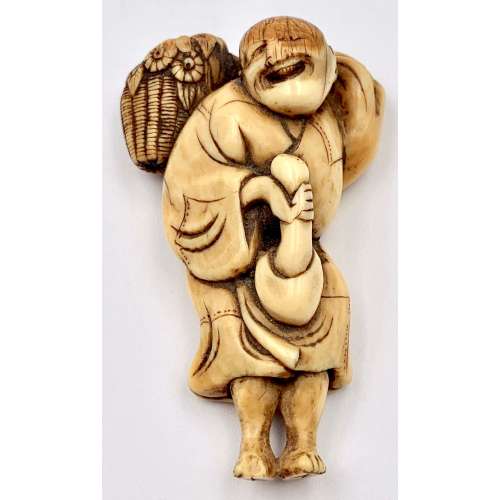
Netsuke with a design of a laughing peasant carrying a basket and holding a giant mushroom in his right hand.
18th century Dimensions: 55.7 mm tallUnsigned. According to Merrily Baird (Symbols of Japan, page. 93): ... This prominent use in the symbol-rich netsuke art form, however, reflects more their sexual symbolism than either their dietary appeal or interesting shapes. Mushrooms in Japan are generally a symbol of fertility, with some flat varieties, like shiitake, being associated with females. In contrast, the matsutake mushroom (Armillaria edodes) is a phallic symbol, as befits its thick, spearlike stem and the fact that it is consumed before cap opens.
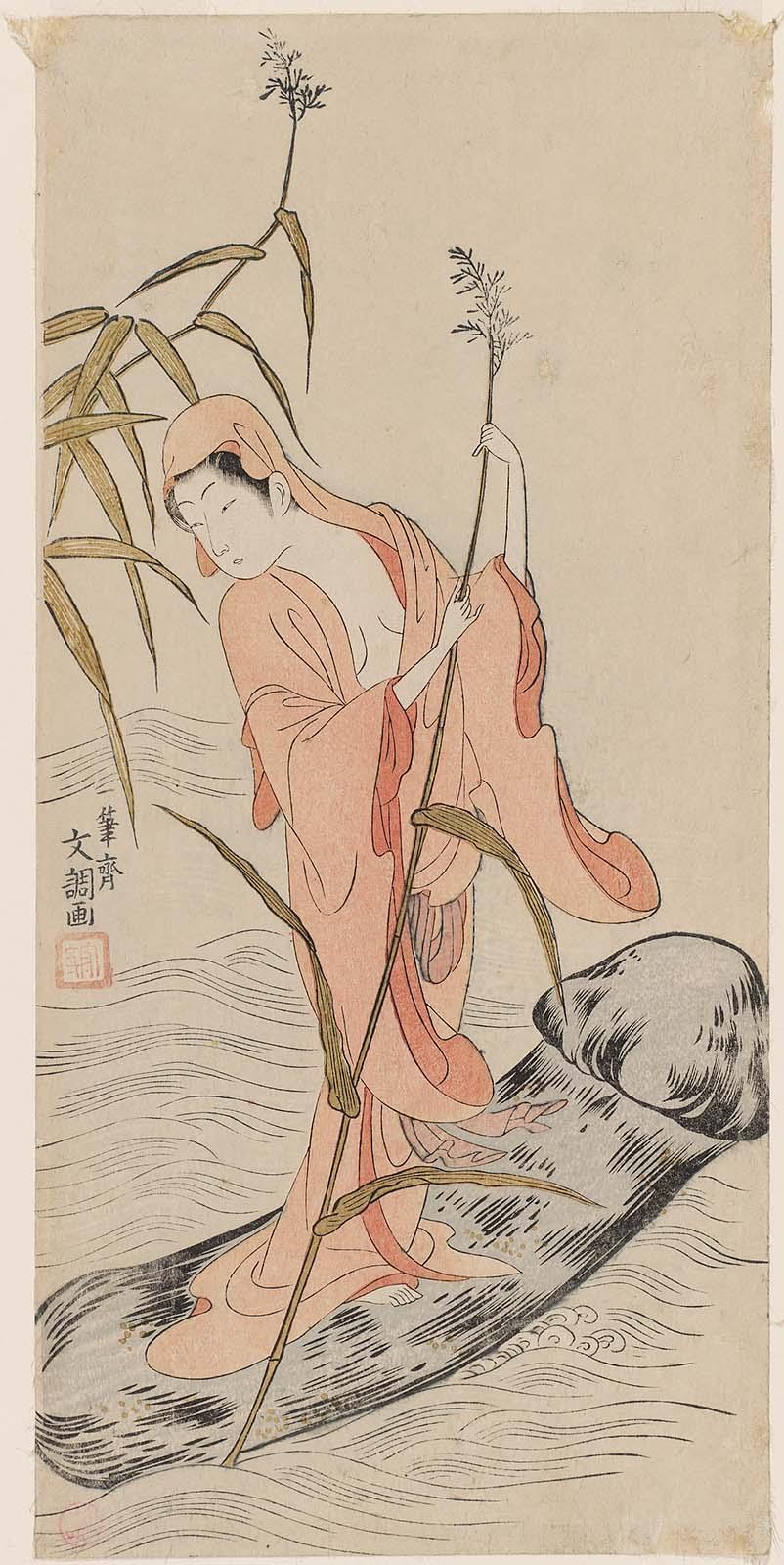
Female Daruma Riding a Mushroom [女達磨]. Ippitsusai Bunchô (1765–1792). MFA impressions: 11.18513, 21.4758
-
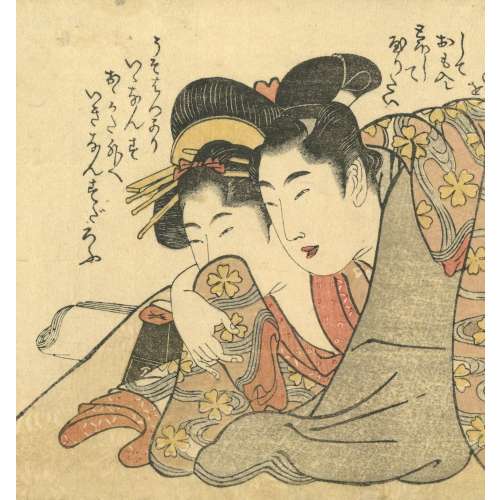 Artist: Kitagawa Utamaro [喜多川 歌麿] (Japanese, c. 1753 – 1806) "This uncommon half-size horizontal ōban ... is most likely one design from a set of twelve prints issued late in Utamaro's life" [Japanese Erotic Fantasies, Hotei Publishing, 2005, p. 143, pl. 47]. Half-size horizontal ōban must be 12.7 x 38 cm. Richard Waldman and Chris Uhlenbeck say it's tanzaku size (13 x 43 cm). In reality, the prints of this series measure 17 x 38 cm, which corresponds exactly to horizontal o-hosoban paper size. I managed to assemble 11 of allegedly 12 designs. 7 of them have genitals colored by hand. It's hard to tell whether it was done by the publisher on demand of a peculiar buyer, or by the owner of the prints who considered the black and white privy parts unnatural. My sequencing of the prints is arbitrary. Transcription of the text may help find the correct order.
Artist: Kitagawa Utamaro [喜多川 歌麿] (Japanese, c. 1753 – 1806) "This uncommon half-size horizontal ōban ... is most likely one design from a set of twelve prints issued late in Utamaro's life" [Japanese Erotic Fantasies, Hotei Publishing, 2005, p. 143, pl. 47]. Half-size horizontal ōban must be 12.7 x 38 cm. Richard Waldman and Chris Uhlenbeck say it's tanzaku size (13 x 43 cm). In reality, the prints of this series measure 17 x 38 cm, which corresponds exactly to horizontal o-hosoban paper size. I managed to assemble 11 of allegedly 12 designs. 7 of them have genitals colored by hand. It's hard to tell whether it was done by the publisher on demand of a peculiar buyer, or by the owner of the prints who considered the black and white privy parts unnatural. My sequencing of the prints is arbitrary. Transcription of the text may help find the correct order. As Japanese Erotic Fantasies put it: "a couple engaged in love-making, their stare fixed outside the picture plane". This is the only image of series that has a reference in available western literature, and the only one found in museum collections: Rijksmuseum Amsterdam (RP-P-1999-2001-16); reference: Fukuda (ed.) (1990), pls. 11-2.
As Japanese Erotic Fantasies put it: "a couple engaged in love-making, their stare fixed outside the picture plane". This is the only image of series that has a reference in available western literature, and the only one found in museum collections: Rijksmuseum Amsterdam (RP-P-1999-2001-16); reference: Fukuda (ed.) (1990), pls. 11-2.
 The scene of this print looks quite similar to that of the Kiyonaga's Sode no maki:
The scene of this print looks quite similar to that of the Kiyonaga's Sode no maki:
 The woman is "a young lady-in-waiting of Shogun's Court or Daimyō's Mansion, enjoying a rare outing from her tedious chores" [Richard Lane]. She is fully dressed in her outer cloak (shikake), white paper hat (agebōshi or tsunokakushi), and toed socks (tabi). A book or maybe, onkotogami (roll of tissues known as 'paper for honourable act' ) is still in the folds of her kimono. She is holding an open fan, either to cover her and her lover's faces from an unsolicited witness or to bring some fresh air to their joined lips. The pair just started their sexual intercourse.
The woman is "a young lady-in-waiting of Shogun's Court or Daimyō's Mansion, enjoying a rare outing from her tedious chores" [Richard Lane]. She is fully dressed in her outer cloak (shikake), white paper hat (agebōshi or tsunokakushi), and toed socks (tabi). A book or maybe, onkotogami (roll of tissues known as 'paper for honourable act' ) is still in the folds of her kimono. She is holding an open fan, either to cover her and her lover's faces from an unsolicited witness or to bring some fresh air to their joined lips. The pair just started their sexual intercourse.
 A scene from medieval times. A courtier in eboshi cap having sex with an aristocratic young woman with a long straight hairstyle (suihatsu).
A scene from medieval times. A courtier in eboshi cap having sex with an aristocratic young woman with a long straight hairstyle (suihatsu).
 Completely naked couple in the moment of ejaculation. Lavish garments with paulownia leaves on a yellow background counterbalance the white bodies on red bedding. The form of a woman's cheeks is telling, but I don't know about what. Maybe her advanced age?
Completely naked couple in the moment of ejaculation. Lavish garments with paulownia leaves on a yellow background counterbalance the white bodies on red bedding. The form of a woman's cheeks is telling, but I don't know about what. Maybe her advanced age?
 The pose of the couple and the overall composition are similar to that of the previous sheet. Though the lovers are dressed, and the woman's hairdo is well kept. The male looks older and the woman - younger.
The pose of the couple and the overall composition are similar to that of the previous sheet. Though the lovers are dressed, and the woman's hairdo is well kept. The male looks older and the woman - younger.
 A man takes a young maid from behind. She clenches the sleeve of her kimono in her teeth; it's either the moment of penetration (beginning of intercourse) or of her orgasm (the end of it).
A man takes a young maid from behind. She clenches the sleeve of her kimono in her teeth; it's either the moment of penetration (beginning of intercourse) or of her orgasm (the end of it).
 This seems to be a forced intercourse between a lackey with extensive bodily hair and a young maid from the same household.
This seems to be a forced intercourse between a lackey with extensive bodily hair and a young maid from the same household.
 This design is very much like the other one presented below, which is described at Japanese Erotic Fantasies on page 136 (pl. 43b) as follows: "The viewer peers through a mosquito net to see a child fast asleep, while his mother or wet-nurse moves towards her partner. On our print there is no child; instead of a sleeping baby, there is a roll of onkotogami. Fewer objects make the overall image concise, almost laconic in comparison with the Ehon hana fubuki (1802) design:
This design is very much like the other one presented below, which is described at Japanese Erotic Fantasies on page 136 (pl. 43b) as follows: "The viewer peers through a mosquito net to see a child fast asleep, while his mother or wet-nurse moves towards her partner. On our print there is no child; instead of a sleeping baby, there is a roll of onkotogami. Fewer objects make the overall image concise, almost laconic in comparison with the Ehon hana fubuki (1802) design:

 A young couple in a moment of true love. He is listening to the beating of her heart.
A young couple in a moment of true love. He is listening to the beating of her heart.
 This is a moment of true love between an old monk and a young samurai. The latter even did not take of his socks (tabi).
This is a moment of true love between an old monk and a young samurai. The latter even did not take of his socks (tabi).
 From Japanese Erotic Fantasies: "Boats played a crucial role in the workings of Yoshiwara, as they were the primary means of transport to the district. During the hot summer months, trips on pleasure boats were also a favourite pastime. Sex aboard a boat is a recurrent theme in shunga".
The last print that I am currently lacking and hunting for:
From Japanese Erotic Fantasies: "Boats played a crucial role in the workings of Yoshiwara, as they were the primary means of transport to the district. During the hot summer months, trips on pleasure boats were also a favourite pastime. Sex aboard a boat is a recurrent theme in shunga".
The last print that I am currently lacking and hunting for:
 I know where it is, but I cannot reach it... yet.
I know where it is, but I cannot reach it... yet. -
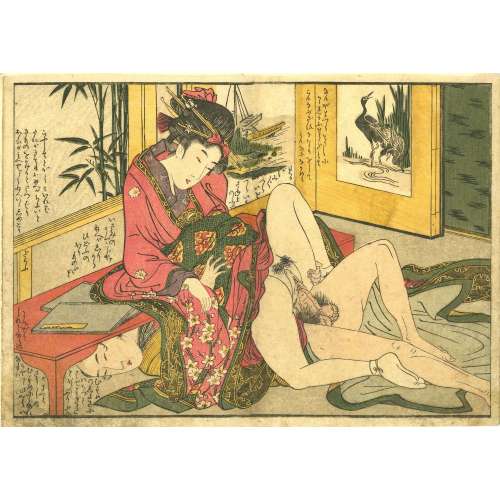 Kitagawa Utamaro. Illustration from book Ehon koi no Onamaki, published in 1799. Reference found by Chris Uhlenbeck: he found one of the designs in Hayashi Yoshikazu's 20-volume set Edo makura-e shi shusei: Kitagawa Utamaro. Size: Chuban (25.5 x 18.5 cm), two book pages glued together.
Kitagawa Utamaro. Illustration from book Ehon koi no Onamaki, published in 1799. Reference found by Chris Uhlenbeck: he found one of the designs in Hayashi Yoshikazu's 20-volume set Edo makura-e shi shusei: Kitagawa Utamaro. Size: Chuban (25.5 x 18.5 cm), two book pages glued together. -
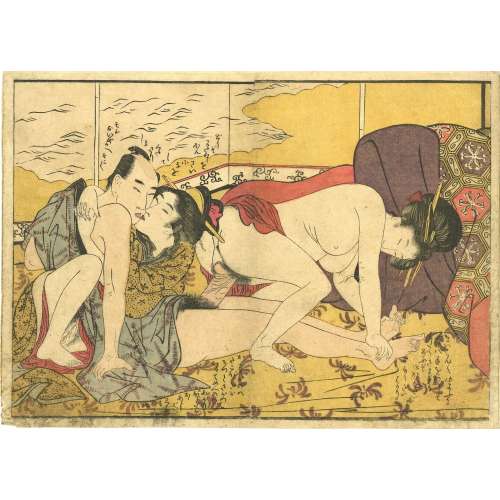 Kitagawa Utamaro. Illustration from the book Ehon koi no Onamaki. Cited at Hayashi Yoshikazu's 20-volume set Edo makura-e shi shusei: Kitagawa Utamaro. Size: Chuban (25.5 x 18.5 cm), two book pages glued together.
Kitagawa Utamaro. Illustration from the book Ehon koi no Onamaki. Cited at Hayashi Yoshikazu's 20-volume set Edo makura-e shi shusei: Kitagawa Utamaro. Size: Chuban (25.5 x 18.5 cm), two book pages glued together. -
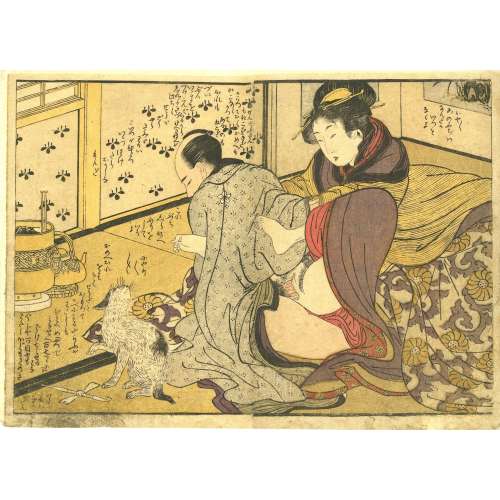 Kitagawa Utamaro. According to Chris Uhlenberg this is an illustration from the book Ehon koi no Onamaki, 3 vols, published in Kansei 11 (1799). Illustrated in b/w in: Hayashi Yoshikazu: Kitagawa Utamaro, in the series: Edo makura-e shi shusei, published in 1990, reissued 1994. Size: Chuban (25.5 x 18.5 cm), two book pages glued together.
Kitagawa Utamaro. According to Chris Uhlenberg this is an illustration from the book Ehon koi no Onamaki, 3 vols, published in Kansei 11 (1799). Illustrated in b/w in: Hayashi Yoshikazu: Kitagawa Utamaro, in the series: Edo makura-e shi shusei, published in 1990, reissued 1994. Size: Chuban (25.5 x 18.5 cm), two book pages glued together. -
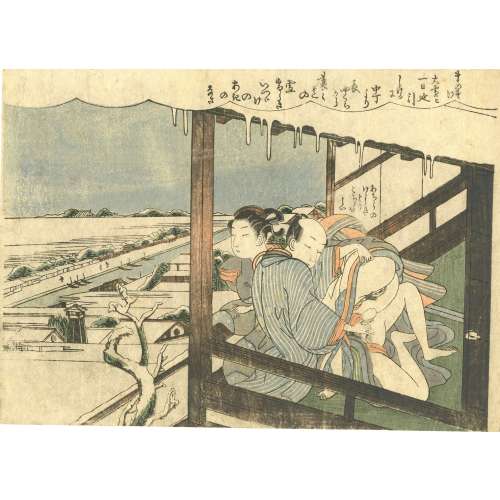 Unsigned print, attributed to Suzuki Harunobu. Erotic scene on open veranda with a winter landscape on background.
Unsigned print, attributed to Suzuki Harunobu. Erotic scene on open veranda with a winter landscape on background. -
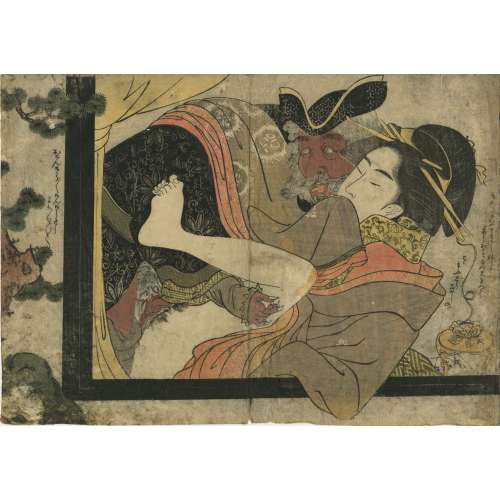 Woodblock print album of thirteen prints, ōban, nishiki-e. Artist: Chōkyōsai Eiri [鳥橋斎 栄里] (Japanese, fl. c. 1789 ~ 1801 ). Models of calligraphy (Fumi no kiyogaki), New Year 1801. This title is taken from Chris Uhlenbeck's Japanese Erotic Fantasies Sexual Imagery of the Edo Period. — Hotei Publishing, 2005, ISBN 90-74822-66-5):. A detailed description of the album can be found at The Complete Ukiyo-e Shunga №9 Eiri, 1996, ISBN 4-309-91019. Most of the edition is in Japanese, though Richard Lane writes a section in English: Eiri: Love-letters, Love Consummated: Fumi-no-kiyogaki. The article starts with the following statement: "Why all the fuss about Sharaku? Because he is so "mysterious"? No, not at all: because he is such a good artist. But Sharaku is not the only great yet enigmatic ukiyo-e artist and I propose to resurrect here one of his important contemporaries who has been all too long neglected: Chōkyōsai Eiri. As with many of the notable ukiyo-e masters, nothing is known of Eiri's biography. All we can say is what we learn from his extant prints and paintings: that he flourished during the second half of the Kansei Period [1789-1801]; and that he was a direct pupil of the great Eishi - who, being of eminent samurai stock, may well have attracted pupils of similar background." Another citation from Japanese Erotic Fantasies: "This album is one of the boldest sets of ōban-size shunga known, The first edition contains thirteen instead of the customary twelve designs". Here I present all thirteen prints, though the edition I bought in Kyoto in 2014 contained only twelve. The thirteenth print was purchased later in the United States (sheet №12).
Woodblock print album of thirteen prints, ōban, nishiki-e. Artist: Chōkyōsai Eiri [鳥橋斎 栄里] (Japanese, fl. c. 1789 ~ 1801 ). Models of calligraphy (Fumi no kiyogaki), New Year 1801. This title is taken from Chris Uhlenbeck's Japanese Erotic Fantasies Sexual Imagery of the Edo Period. — Hotei Publishing, 2005, ISBN 90-74822-66-5):. A detailed description of the album can be found at The Complete Ukiyo-e Shunga №9 Eiri, 1996, ISBN 4-309-91019. Most of the edition is in Japanese, though Richard Lane writes a section in English: Eiri: Love-letters, Love Consummated: Fumi-no-kiyogaki. The article starts with the following statement: "Why all the fuss about Sharaku? Because he is so "mysterious"? No, not at all: because he is such a good artist. But Sharaku is not the only great yet enigmatic ukiyo-e artist and I propose to resurrect here one of his important contemporaries who has been all too long neglected: Chōkyōsai Eiri. As with many of the notable ukiyo-e masters, nothing is known of Eiri's biography. All we can say is what we learn from his extant prints and paintings: that he flourished during the second half of the Kansei Period [1789-1801]; and that he was a direct pupil of the great Eishi - who, being of eminent samurai stock, may well have attracted pupils of similar background." Another citation from Japanese Erotic Fantasies: "This album is one of the boldest sets of ōban-size shunga known, The first edition contains thirteen instead of the customary twelve designs". Here I present all thirteen prints, though the edition I bought in Kyoto in 2014 contained only twelve. The thirteenth print was purchased later in the United States (sheet №12). №1: "...one of the most exotic scenes in all shunga. A Dutch kapitan is discovered coupling with a lovely Japanese courtesan, beside a large window opening upon a garden...".
№1: "...one of the most exotic scenes in all shunga. A Dutch kapitan is discovered coupling with a lovely Japanese courtesan, beside a large window opening upon a garden...".

 №2: "...a fair young harlot is seen masturbating with a grinding-pestle - a man watches intently from under bedding." [I have two specimens of this design; the one from album is more soiled but less faded].
№2: "...a fair young harlot is seen masturbating with a grinding-pestle - a man watches intently from under bedding." [I have two specimens of this design; the one from album is more soiled but less faded].
 №3: "...the artist has effectively contrasted the lovers by depicting the man's face as seen through the geisha's gauze skirt. [...] we are impressed more by strikingly elegant composition, the dramatic coloring, rather than feeling any great urge to participate in the energetic proceedings..."
№3: "...the artist has effectively contrasted the lovers by depicting the man's face as seen through the geisha's gauze skirt. [...] we are impressed more by strikingly elegant composition, the dramatic coloring, rather than feeling any great urge to participate in the energetic proceedings..."
 №4: "This scene is a most straightforward one, featuring the standard Missionary Position [capitalization by R. Lane].; but withal, the contrast of the young and naked, secret lover and the richly-clothed courtesan amid luxurious bedding..."
№4: "This scene is a most straightforward one, featuring the standard Missionary Position [capitalization by R. Lane].; but withal, the contrast of the young and naked, secret lover and the richly-clothed courtesan amid luxurious bedding..."
 №5: "In a striking lesbian scene (which has no equivalent in Utamaro, and is, incidentally, often omitted in later editions of this album), the girl at left prepares to receive the harikata (dildo) worn by the older girl at right (who holds a seashell containing lubricant)."
№5: "In a striking lesbian scene (which has no equivalent in Utamaro, and is, incidentally, often omitted in later editions of this album), the girl at left prepares to receive the harikata (dildo) worn by the older girl at right (who holds a seashell containing lubricant)."
 №6: "In the first appearance of a matronly heroine in this series, we find a widow - with shaven eyebrows and clipped hair - sporting with a handsome yound shop-clerk, mounting him with all her might."
№6: "In the first appearance of a matronly heroine in this series, we find a widow - with shaven eyebrows and clipped hair - sporting with a handsome yound shop-clerk, mounting him with all her might."

 №7: "... lady of samurai court: here, shown taking advantage of an official outing to temple and theatre, to rendezvous with a secret lover on a teahouse balcony." R. Lane considers this design the least successful in the series, especially in comparison with the same theme by Utamaro: "Utamaro female is almost ferocious in her lust for sexual gratification", which does not sound true to me. See Utamaro's sheet №5 from the album Utamakura (歌まくら, Poem of the Pillow) [courtesy The British Museum without permission]:
№7: "... lady of samurai court: here, shown taking advantage of an official outing to temple and theatre, to rendezvous with a secret lover on a teahouse balcony." R. Lane considers this design the least successful in the series, especially in comparison with the same theme by Utamaro: "Utamaro female is almost ferocious in her lust for sexual gratification", which does not sound true to me. See Utamaro's sheet №5 from the album Utamakura (歌まくら, Poem of the Pillow) [courtesy The British Museum without permission]:
 Then, as Richard Lane states, "we are flung suddenly to the bottom rung of Edo society":
Then, as Richard Lane states, "we are flung suddenly to the bottom rung of Edo society":
 №8: "Here we find a fair yotaka ('night-hawk', e.i. streetwalker) accommodating a lusty client in a lumberyard by the bank of the Sumida River".
№8: "Here we find a fair yotaka ('night-hawk', e.i. streetwalker) accommodating a lusty client in a lumberyard by the bank of the Sumida River".
 №9: '... a slightly plump harlot of the lower class receives a night visit from her lover, whose naked form she tries to cover with a cloak."
№9: '... a slightly plump harlot of the lower class receives a night visit from her lover, whose naked form she tries to cover with a cloak."
 №10: "...likely maidservant and lackey - are depicted in bath-room, their passions are all too obviously fired by steaming water."
№10: "...likely maidservant and lackey - are depicted in bath-room, their passions are all too obviously fired by steaming water."
 №11: "...this scene of courtesan and secret lover ranks high not only in Eiri's œuvre but also in the annals of the ukiyo-e genre itself. Both design and colouring are impeccable and, for this period, there is nothing even in the work of great Utamaro that really surpasses it." Again, a doubtful statement, however, this is Utamaro's design for the reader to judge:
№11: "...this scene of courtesan and secret lover ranks high not only in Eiri's œuvre but also in the annals of the ukiyo-e genre itself. Both design and colouring are impeccable and, for this period, there is nothing even in the work of great Utamaro that really surpasses it." Again, a doubtful statement, however, this is Utamaro's design for the reader to judge:
 The last design in my album is this:
The last design in my album is this:
 #13: In most reference books it goes under number 13, and we will assign this number to the sheet. "The final scene of the album features naked participants, probably samurai man and wife. The print is rather subdued in tone and colour, if not in the degree of the passion displayed..."
An additional sheet, acquired separately from a reputable dealer in New York, is usually listed as №12:
#13: In most reference books it goes under number 13, and we will assign this number to the sheet. "The final scene of the album features naked participants, probably samurai man and wife. The print is rather subdued in tone and colour, if not in the degree of the passion displayed..."
An additional sheet, acquired separately from a reputable dealer in New York, is usually listed as №12:
 №12: "One might think that Eiri has reached his peak with the preceding plate 11 - and indeed he has, in both esthetic and erotic terms. But the album is not yet finished, and the next scene lends a needed variety to the series, a slightly comic tableau featuring a middle-aged lackey attempting to forcibly seduce a servant girl of the same domicile". Utamaro's design, that inspired Eiri is here:
№12: "One might think that Eiri has reached his peak with the preceding plate 11 - and indeed he has, in both esthetic and erotic terms. But the album is not yet finished, and the next scene lends a needed variety to the series, a slightly comic tableau featuring a middle-aged lackey attempting to forcibly seduce a servant girl of the same domicile". Utamaro's design, that inspired Eiri is here:
 All descriptions are taken from Richard Lane's article at The Complete Ukiyo-e Shunga №9 Eiri, 1996. He concluded: "...Eiri's erotic series represents a major contribution to shunga art towards the close of ukiyo-e "Golden Age". In part inspired by Utamaro's classic album, this series withal constitutes a unified and original achievement, providing a cumulative effect of gracefully elegant yet glowing eroticism, which remains in the mind's eye long after the pictures themselves are far away."
I only would like to mention here that in several reference sources this album goes under name of Eisho; unfortunately, this mistake is reproduced at www.ukiyo-e.org, which miraculously shows exactly my print, but under the wrong name of the artist. The same mistake can be found at Shunga. The art of love in Japan. Tom and Mary Anne Evans. Paddington Press Ltd., 1975. ISBN 0-8467-0066-2; plates 6.74-6.77: Chōkyōsai Eishō, c. 1800. Even the British Museum edition of 2010 gives the same erroneous attribution: Chōkyōsai Eishō (1793-1801); they provide the following translation of title: "Clean Draft of a Letter" [see: Shunga. Erotic art in Japan. Rosina Buckland. The British Museum Press, 2010; pp. 110-112]. To the honour of the British Museum, I must admit that they have corrected themselves in Shunga. Sex and pleasure in Japanese art. Edited by Timothy Clark, et al. Hotei Publishing, 2013. Now, they say Chōkyōsai Eiri (worked c. 1790s-1801); they also provide a new title: "Neat Version of the Love Letter, or Pure Drawings of Female Beauty". I have already mentioned Richard Lane's version of title: "Love-letters, Love Consummated", and Chris Uhlenbeck's "Models of calligraphy". In poorly designed and printed Shunga. Erotic figures in Japanese art. Presented by Gabriele Mandel. Translated by Alison L'Eplattenier. Crescent Books, New York, 1983, the artist is named Shokyosai Eisho (beginning of the 19th century); title provided: "Models of Calligraphy". Correct attribution to Chōkyōsai Eiri also can be found at Poem of the pillow and other stories by Utamaro, Hokusai, Kuniyoshi and other artists of the floating world. Gian Carlo Calza in collaboration with Stefania Piotti. Phaidon Press, 2010; though the title is translated as "Clean Copy of Female Beauty".
All descriptions are taken from Richard Lane's article at The Complete Ukiyo-e Shunga №9 Eiri, 1996. He concluded: "...Eiri's erotic series represents a major contribution to shunga art towards the close of ukiyo-e "Golden Age". In part inspired by Utamaro's classic album, this series withal constitutes a unified and original achievement, providing a cumulative effect of gracefully elegant yet glowing eroticism, which remains in the mind's eye long after the pictures themselves are far away."
I only would like to mention here that in several reference sources this album goes under name of Eisho; unfortunately, this mistake is reproduced at www.ukiyo-e.org, which miraculously shows exactly my print, but under the wrong name of the artist. The same mistake can be found at Shunga. The art of love in Japan. Tom and Mary Anne Evans. Paddington Press Ltd., 1975. ISBN 0-8467-0066-2; plates 6.74-6.77: Chōkyōsai Eishō, c. 1800. Even the British Museum edition of 2010 gives the same erroneous attribution: Chōkyōsai Eishō (1793-1801); they provide the following translation of title: "Clean Draft of a Letter" [see: Shunga. Erotic art in Japan. Rosina Buckland. The British Museum Press, 2010; pp. 110-112]. To the honour of the British Museum, I must admit that they have corrected themselves in Shunga. Sex and pleasure in Japanese art. Edited by Timothy Clark, et al. Hotei Publishing, 2013. Now, they say Chōkyōsai Eiri (worked c. 1790s-1801); they also provide a new title: "Neat Version of the Love Letter, or Pure Drawings of Female Beauty". I have already mentioned Richard Lane's version of title: "Love-letters, Love Consummated", and Chris Uhlenbeck's "Models of calligraphy". In poorly designed and printed Shunga. Erotic figures in Japanese art. Presented by Gabriele Mandel. Translated by Alison L'Eplattenier. Crescent Books, New York, 1983, the artist is named Shokyosai Eisho (beginning of the 19th century); title provided: "Models of Calligraphy". Correct attribution to Chōkyōsai Eiri also can be found at Poem of the pillow and other stories by Utamaro, Hokusai, Kuniyoshi and other artists of the floating world. Gian Carlo Calza in collaboration with Stefania Piotti. Phaidon Press, 2010; though the title is translated as "Clean Copy of Female Beauty".
-
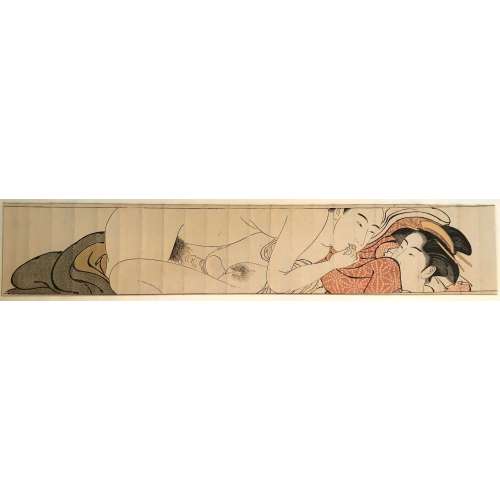 Artist: Torii Kiyonaga [鳥居 清長] (Japanese, 1752 – 1815) Color woodblock print: makimono-e (11.4 x 65.4 cm). Year: c. 1785. Three sheets of the series of twelve, № 6, № 9, and № 11, "from Kiyonaga's most idiosyncratic and celebrated series of pornography. It was designed as part of a miniature handscroll (makimono) to place in one's sleeve, where it was carried both for its stimulatory and for its talismanic properties." [LIB-1474.2018] Important Japanese prints from the collection of Henry Steiner by Sebastian Izzard.]№ 6: "The woman's blackened teeth indicate that she is a wife. This middle-aged couple is relaxing and drowsing after lovemaking. The scene is peaceful now., but the pillow cast aside hints at their earlier, passionate lovemaking".
Artist: Torii Kiyonaga [鳥居 清長] (Japanese, 1752 – 1815) Color woodblock print: makimono-e (11.4 x 65.4 cm). Year: c. 1785. Three sheets of the series of twelve, № 6, № 9, and № 11, "from Kiyonaga's most idiosyncratic and celebrated series of pornography. It was designed as part of a miniature handscroll (makimono) to place in one's sleeve, where it was carried both for its stimulatory and for its talismanic properties." [LIB-1474.2018] Important Japanese prints from the collection of Henry Steiner by Sebastian Izzard.]№ 6: "The woman's blackened teeth indicate that she is a wife. This middle-aged couple is relaxing and drowsing after lovemaking. The scene is peaceful now., but the pillow cast aside hints at their earlier, passionate lovemaking".
Picture № 6. (31d in LIB-2971.2022)
№ 9: "This looks to be the first sexual experience of a young woman of a well-to-do family, who covers her mouth shyly. The more experienced man moistens his fingers with saliva, eager to explore the young woman's body".
Picture № 9.
№ 11: "The woman wears a so-called Iwata sash signalling that she is pregnant. The man approaches from behind so as not to put pressure on her stomach. He shows care and gentle consideration toward his pregnant wife, who appears relaxed". Picture descriptions from Shunga: Sex and Pleasure in Japanese art. Edited by Timothy Clark, C. Andrew Gerstle, Aki Ishigami, Akiki Yano. Hotei Publishing, 2013. Ref.: [LIB-2971.2022] Chris Uhlenbeck, Margarita Winkel. Japanese erotic fantasies sexual imagery of the Edo period. — Amsterdam: Hotei Publishing, ©2005; p. 118-9 (№ 31).
Picture № 11. (31g in LIB-2971.2022)
-
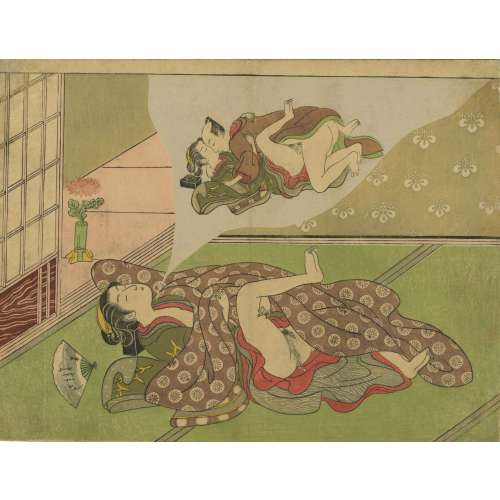 Attributed to Suzuki Harunobu (Japanese: 鈴木 春信; c. 1725 – 7 July 1770). Sunga. Woman dreaming of making love. British museum attributes to Ippitsusai Buncho (一筆斉文調).
Attributed to Suzuki Harunobu (Japanese: 鈴木 春信; c. 1725 – 7 July 1770). Sunga. Woman dreaming of making love. British museum attributes to Ippitsusai Buncho (一筆斉文調).


